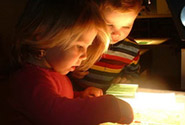Counting - Stuck in the 20s

Ethan and Eli, almost five years old, take turns counting about 40 seeds. If we watch the details of their actions, we see a number of cases where they give two number words to the same seed and sometimes skip a number word, e.g. saying 28 after saying 26. Both boys do say a word each time they point, but not necessarily the next word in the number sequence and not necessarily one word per seed. Can we say the boys are being careless or that they are carefully applying their incomplete knowledge? Given the deliberateness of their movements, perhaps the latter interpretation is the better one. They are in that transition from counting their pointing actions to counting the seeds as separate objects. That is, the number words seem to be applied to the action of moving a seed rather than counting the transfer of one seed to the counted pile. So, when a seed slips from one of their fingers, instead of saying the same number when touching it again with a firmer press, they shift to a new number word. This strategy happens some of the time, but not all of the time, again indicating that the boys do not yet appreciate that a reliable count must bow to a rigid application of the one number word per object counted in conventional sequence. The most interesting strategy happens for both boys when they get to 29. Neither seems to remember that "thirty" comes after 29. Ethan (first child counting) cycles back through the high twenties. He knows what he is doing. We hear him say when Eli counts the same way, at 03:21, "He's counting like me. I don't know how to finish, so I just did it again and again and again." Counting requires the correct application of rules, and thereby should be treated as more than a rote skill. These boys know that they need a way to mark the counted from the uncounted. They apply this rule consistently by moving the seeds from one pile to the next. Indeed, at 01:20 Ethan clusters his counted seeds into a tighter grouping, as if to make sure they do not get confused with the uncounted seeds. Next, perhaps because he has forgotten what to say after 29, Ethan makes a word that sounds like "one." He does not like that word, so on the next count he says ,"Tur six, tur five, tur four, tur three, tur two, two one, thirty, twenty seven, twenty six. ... twenty six, that's a lot.” Why does Ethan start to count backwards? Perhaps he knows he will hit a wall if he counts forward. But he also knows number words have a defined sequence. So, to keep the sequence rule he counts backwards and thereby avoids hitting the wall of not knowing what to say after 29. In his verbalizations of counting backwards, he does say, "Thirty." But he is too committed to getting to the end to recognize that "thirty" is the missing number word that prevented him from finishing his forward count. For both boys we can see the clever adjustments that they make to their counting strategies. They are engaged in high level thinking as they realize that something is wrong. Click here to download a detailed transcript, including comments, of this video title. Keywords: fours, children-children, math, counting Length of video: 4 minutes 47 seconds
